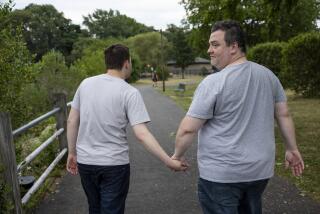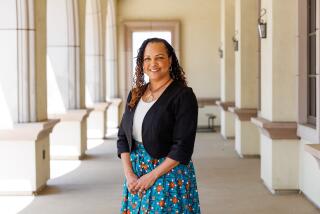Therapy Hits the Right Key : A CSUN Clinic Utilizes Music in Treatment of the Mentally Disabled
- Share via
NORTHRIDGE — Jake Masterson could barely interact with people. Born with a rare chromosomal brain disorder that caused him to behave much like a severely autistic child, the 3-year-old did not talk, rarely made eye contact with others and did not respond to speech or most sounds.
Except music.
After years of living in a lonely world that even his parents could seldom penetrate, one day last November Jake began to play simple musical instruments. He began to dance.
Suddenly, he started to recognize and smile at the person who brought music into his life: his music therapist, Cal State Northridge student Shelly Waldheim.
Waldheim is one of about three dozen CSUN students learning the art and practice of music therapy, a little-known but growing field that uses music, rhythm and sound to help people--mostly the mentally disabled--develop emotional skills and physical coordination.
On Monday, CSUN officially opened a professional clinic, which the school says is the first of its kind on the West Coast, offering private music-therapy sessions.
More than 20 clients have already signed up.
“For a child who can’t communicate, to be able to connect with something like music is great,” said Julie Masterson, Jake’s mother. “There aren’t a lot of things Jake does where you can tell he is really enjoying himself. Now, he will have music for the rest of his life.”
People afflicted with Alzheimer’s disease, strokes or congenital brain disorders--mostly those who cannot communicate verbally--are flocking to music therapy, according to a Al Bumanis, spokesman for the National Assn. for Music Therapy in Maryland.
Through melody and rhythm, many are able to express themselves emotionally and interact and communicate with others, opportunities many never get outside of music.
Although it is almost impossible to conclusively prove that music therapy helps heal patients, doctors said, studies have proved that parts of the brain that process sounds and control emotions are significantly linked and music affects physical functions such as heart rate and blood pressure.
Countless case studies and first-hand experience provide much evidence, doctors say, that the worst potential side effects of music therapy are patients irritated by music they don’t like or unruly children who hit one another with drumsticks.
Experts say music therapy has been around for centuries in various forms, dating back to ancient Greek and Native American healers.
The National Assn. for Music Therapy, which has about 3,400 registered members, was started more than 45 years ago when wounded World War II veterans were found to heal more quickly and thoroughly if music was a regular part of their recovery.
“It is not for everyone, just like Ritalin or Prozac is not for everyone,” said Dr. Bryan King, a child psychiatrist at UCLA.
“But it can really be the most profound way to reach a particular person. It is not viewed as quackery or anything of the sort. It just expands the menu of ways that you can reach someone.”
About six clinics devoted solely to music therapy are operating around the nation, said Ron Borczon, director of the university’s music therapy clinic. Three universities in California and 68 universities nationwide offer degrees in music therapy, Bumanis said.
Dr. Mark Tramo, a neuroscientist at Harvard Medical School, has used music therapy to treat stroke patients.
“Some of them lose the ability to speak, but--it’s amazing--some of them can still sing,” Tramo said, noting that singing and talking are controlled by different parts of the brain. “At least they can use some kind of voicing to allow them to communicate.”
Therapy is different for each patient. Musical outlets from mellow chanting and vigorous drum beating to maraca rattling and simple piano lessons are used in varying combinations, all aimed at connecting patients emotionally with sound.
Like many other patients, Jake cannot play an instrument himself, but he spends much of his time listening carefully and moving to the rhythms.
But even when children are crying uncontrollably, music instantly calms and engages them like nothing else, Waldheim said.
“When I play the guitar or the recorder, it’s like he goes into a trance,” Waldheim said. “He stares and stares at me, with his face two inches from mine. He is a completely different child when there is music around him. He really needs something to engage him, and music seems to be it.”
The CSUN clinic, located in the university’s music building, now consists of a classroom filled with drums, rattles, a piano and a host of percussion and rhythm instruments from all over the world.
Borczon and one other certified music therapist, along with about 30 students, all of whom play instruments, run the clinic. The therapists are certified by The National Assn. for Music Therapy.
In CSUN’s clinic, Evan Fischer, who is autistic, comes each Monday afternoon for a half-hour piano lesson.
Having had music therapy for more than five years, Evan, 17, now reads music and has honed his coordination and rhythm skills more than it was thought he could, given his disability.
“I love the piano,” Evan said, smiling and clutching his music notebook. “It is good for my fingers.”
More to Read
Sign up for Essential California
The most important California stories and recommendations in your inbox every morning.
You may occasionally receive promotional content from the Los Angeles Times.













